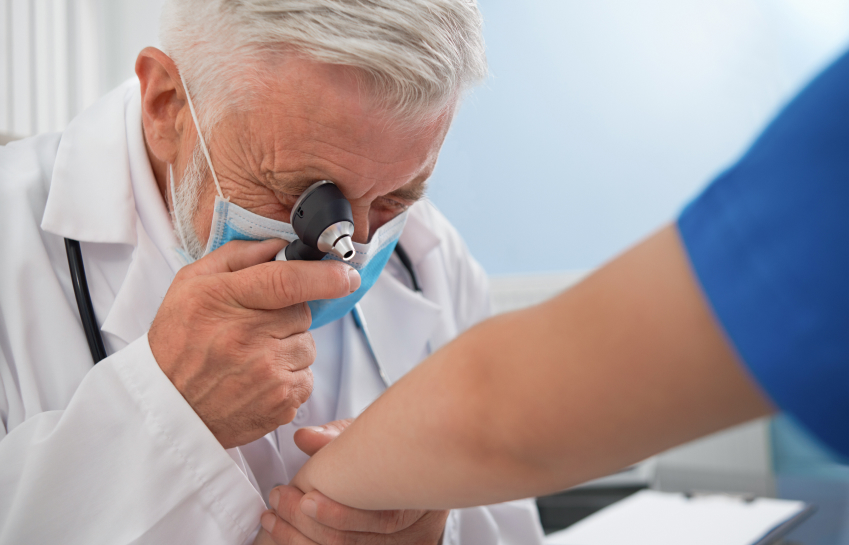During this blog I’d like to have a discussion about normal moles and melanomas and distinguishing the difference between the two. As we are coming into the summer months and we all want to get out into the sun, it’s really important that we protect our skin with sunscreen, it needs to be an adequate balance of exposure to the sun and getting an adequate dose of vitamin D for the day and then UV rays causing sun damage.
Firstly, I will discuss normal moles and freckles and how we can distinguish the difference, normal moles appear in the first few decades of life, in almost everyone and are very common small brown spots or growths on the skin, they appear very flat, however, some can be a little bit elevated and are usually round and regular in shape, in many cases, they are caused by sun exposure, there are different names for them all, freckles and age spots are flat, they occur with sun exposure and multiple spots characteristically occur together. Age spots can be light or dark they can be brown or black, they are uniform in colour, all one colour, age spots are harmless and could be treated by several methods for cosmetic reasons, but do not necessarily need to be treated. Some changes occur to your skin automatically with age, such as age spots, these are also called liver spots, but they have nothing medical to do with the liver, they are caused by long term sun exposure.
There are three common types of age spots, some that we see are little red dots and these are called cherry hemangiomas, small red dots that are smaller than a pencil eraser, that are caused by an overgrowth of blood vessels in the skin, but they’re not linked to any kind of skin cancer, lentigines are flat, they are dark in colour, this is the next kind of very common age spot, their size is usually up to a 5p coin and what most people think of with these age spots, is they are located on sun exposed areas. Seborrhoeic keratosis is the third type, it’s flat or it can be a little bit raised and range from pale to dark brown, they can be scaly or wart like in appearance, although they’re not warts, caused by sunlight or genetic exposure, they can be linked to skin tags, another benign skin growths, as a general rule, if you see a new skin spot and you are concerned about it get it checked out. Some changes with the skin come with age, though if you are over 50 or have a personal or family history of skin cancer, you should just go and have a check up.
Melanoma is the only form of cancer that we can see on the skin and as it shows up quickly, we have the advantage to catch it in the early stages, because we can see it, with faster recovery rates and less spreading, so early detection can save lives, check your spots. Melanoma is the most dangerous form of skin cancer and it can look like a mole or originate from a mole, it can originate from just plain flat skin, most are caused by sun exposure or sunbeds. Sunbeds are more toxic to the body and harmful, as they directly impact UV rays straight into the layers of skin that a melanoma needs to develop. Malignant melanomas develop after UV exposure when unrepaired DNA damages the skin cells, the damaged skin cells trigger mutations, that cause cells to rapidly multiply and cause malignant tumours.
A melanoma in its early stage, can resemble a lentigines or sometimes seborrheic keratosis, however they grow from here. A melanoma is just cancer that starts on the skin, it can start in a mole or normal looking skin, melanoma develops from cells called melanocytes, that grow and divide more quickly than usual. Melanocytes control your pigmentation, the even or uneven skin tones.
A melanoma in men is most commonly seen on the back, and you don’t always look at your own back, so it’s always great to get somebody else in your family to have a look at your skin, if you have any risk factors. In women, they most commonly occur on the legs, most cases of melanoma become irregular in shape, and they develop more than one colour in the mole, it may become itchy and larger than normal, sometimes it can begin to bleed, but they don’t always have to have these specific traits.
There are a few different types of melanoma, one of the most common types is a superficial spreading melanoma in the UK, more common with people of pale skin and freckles, they grow outwards first rather than downwards, this is really important, if they are caught in the early stages they are very easily treated, if they grow downwards into the deeper layers of the skin they can spread into other parts of the body, early detection is paramount!
Nodular melanomas are the next type, faster developing, can quickly grow downwards and if not removed they can spread into other areas of the body. They are often red or black in colour and develop on the head, chest, neck, back, areas that have normal consistency in skin colour but are most exposed to the sun.
Lentigo melanomas most commonly effect older people and sun seekers or people who have had outdoor professions, who are exposed to the sun and UV light day in and day out, they develop over several years and they are flat and develop sideways, they gradually get bigger and change shape.
Acral lentiginous melanomas are a really rare type that develop or grow on the palms of the hands or the soles of the feet, they can develop around a nail or a toenail and most common in people with dark skin.
Melanomas are caused by skin cells that begin to develop abnormally, they are caused by exposure to UV light or sunbed exposure, intense exposure to UV light with an increased risk of melanomas, if you have lots of moles of freckles, if you have pale skin that easily burns, blue eyes, increasing age, red or blonde hair or a family history of melanoma, this is really important, if you’ve got a family history of skin cancer, get those moles checked. If you have previously damaged skin through radiation or chemotherapy, anything that suppresses your immune system, conditions that suppress your immune system, like diabetes or if you’re on medications that suppress your immune system, you’re also at greater risk, and greater exposure.
UVA, UVB and UVC is the most common and dangerous to the skin, but it is filtered by the earth’s atmosphere, so we must protect ourselves from the sun with a good broad-spectrum sunscreen, this is the best thing that you can do to suppress the threat of melanoma. If you find a spot there is treatment available you need to go to the GP and be referred to a dermatologist, who is a skin care specialist, they can have a look under a special magnifying glass to fully examine that spot, getting it checked out is the best thing that you can do, early detection, saves lives.
The ABCDE of melanoma is a good referral tool.
A stands for asymmetrical features when one half of the mole does not match the other half.
B stands for borders, the borders are not smooth or regular, you’re looking for an asymmetrical mole, one side doesn’t match the other and it has irregular borders.
C is for colour, the colour, varies throughout the mole and there is no uniform colour or uniformity of pigmentation, it varies in colour from light to dark, the colour changes in the mole.
D for diameter, it can be greater than 6 mm.
E for evolving changes in the mole, they are variable over time, if it is changing then get it checked out. If you’re unsure at all then get that mole checked.
Normal moles are exactly the opposite of melanoma, normal moles appear in the first few decades of life, in almost everyone and are common small brown spots or growths on the skin. They appear either flat or a little bit elevated, usually round and regular and many are caused by sun exposure and later in life.
The average adult has about 10 to 20 spots or growths, generally normal moles are the opposite, their shape is symmetrical, one side matches the other side in shape, they are round or oval, the border has regular edges that are sharp and well-defined, the colour is uniform it’s all one colour right throughout the mole, either usually tan, brown or skin colour, the diameter is less than 6 mm, normal moles usually resemble one another and often concentrated on sun-exposed areas, such as the face, trunk, arms and legs, although they can be located anywhere on the body.
Moles usually either develop during childhood or by the age of 30 to 40, if your moles are changing and colour, shape or uniformity is changing, or they are evolving, getting bigger in size, then get that mole checked. Look at its colour, look at its shape, is it changing? New moles, old moles, the best you can do is monitor your moles, to protect yourself from melanoma, get those moles checked out.
I hope this has helped a little bit. I’m just distinguishing freckles from melanoma, as it’s a really quick easy way we can check our bodies to save lives, so if you have someone in your family that you’re worried about, or they’ve got a spot, really encourage them to seek a professional opinion.
If you want to come and have a chat with me my number is 07444938248 and I can refer you to a skincare specialist or you can go to your GP and they can refer you to a skincare specialist.
Get those moles checked and protect yourself from melanoma.




